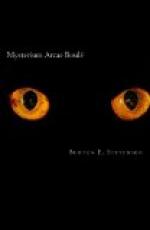Vantine looked at it a little blankly.
“I don’t know him,” he said. “What does he want?”
“He wants to see you, sir; very bad, I should say.”
“What about?”
“Well, I couldn’t just make out, sir; but it seems to be important.”
“Couldn’t make out? What do you mean, Parks?”
“I think he’s a Frenchman, sir; anyway, he don’t know much English. He ain’t much of a looker, sir—I’ve seen hundreds like him sitting out in front of the cafes along the boulevards, taking all afternoon to drink a bock.”
Vantine seemed struck by a sudden idea, and he looked at the card again. Then he tapped it meditatively on the table.
“Shall I show him out, sir?” asked Parks, at last.
“No,” said Vantine, after an instant’s hesitation. “Tell him to wait,” and he dropped the card on the table beside his plate.
“I tell you, Lester,” he went on, as Parks withdrew, “when I went downstairs this morning and saw that cabinet, I could hardly believe my eyes. I thought I knew furniture, but I hadn’t any idea such a cabinet existed. The most beautiful I had ever seen is at the Louvre. It stands in the Salle Louis Fourteenth, to the left as you enter. It belonged to Louis himself. Of course I can’t be certain without a careful examination, but I believe that cabinet, beautiful as it is, is merely the counterpart of this one.”
He paused and looked at me, his eyes bright with the enthusiasm of the connoisseur.
“I’m not sure I understand your jargon,” I said. “What do you mean by ‘counterpart?’”
“Boule furniture,” he explained, “is usually of ebony inlaid with tortoise-shell, and incrusted with arabesques in metals of various kinds. The incrustation had to be very exact, and to get it so, the artist clamped together two plates of equal size and thickness, one of metal, the other of tortoise-shell, traced his design on the top one, and then cut them both out together. The result was two combinations, the original, with a tortoise-shell ground and metal applications; and the counterpart, applique metal with tortoise-shell arabesques. The original was really the one which the artist designed and whose effects he studied; the counterpart was merely a resultant accident with which he was not especially concerned. Understand?”
“Yes, I think so,” I said. “It’s a good deal as though Michael Angelo, when he made one of his sketches, white on black, put a sheet of carbon under his paper and made a copy at the same time, black on white.”
“Precisely. And it’s the original which has the real artistic value. Of course, the counterpart is often beautiful, too, but in a much lower degree.”
“I can understand that,” I said.
“And now, Lester,” Vantine went on, his eyes shining more and more, “if my supposition is correct—if the Grand Louis was content with the counterpart of this cabinet for the long gallery at Versailles, who do you suppose owned the original?”




